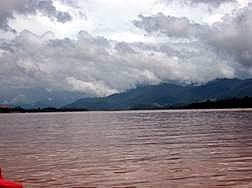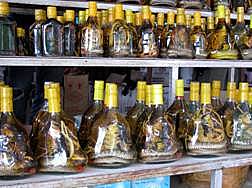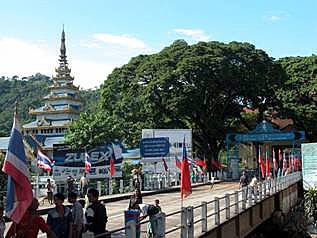The Beetle visited Thailand in September 2006 and had an opportunity to travel to the Golden Triangle, an area that refers to a large, predominantly highland a Laos, Burma and Thailand and at the point where the Ruak and Mekong Rivers merge – see picture right of the Mekhong which shows Laos to the right, Burma to the left and Thailand behind.
– see picture right of the Mekhong which shows Laos to the right, Burma to the left and Thailand behind.
For decades this area saw cross-border smuggling and drug production was rampant; the Golden Triangle was once the centre of all opium poppy growing in Thailand. The opium crops have long since been replaced by the small tourist village of Sob Ruak, and today the roads are flanked by countless small restaurants and vendor's souvenir stalls along the banks of the Mekhong river as well as tourist buses.
 Now, the main thing to do in the Golden Triangle area is to take a boat down the Mekhong (see photo above.) There are oodles of long tail boats are available for hire here and you get to wear a life jacket. Cruising up and down the Mekong River allows visitors a glimpse of village life in the many riverside settlements – particularly in Laos where you can step off and for 15 baht visit a small market which sells bootleg cigarettes, snakes inexplicably coiled in whisky jars (see photo below right) and various items of clothing. Technically you are in Laos when on the island and can claim to have visited the country, although you are not allowed to enter into the rest of Laos from there without a visa. There is also a casino, popular with Thais on the left bank going up the Mekhong, on the Myanmar side and it is possible to visit it.
Now, the main thing to do in the Golden Triangle area is to take a boat down the Mekhong (see photo above.) There are oodles of long tail boats are available for hire here and you get to wear a life jacket. Cruising up and down the Mekong River allows visitors a glimpse of village life in the many riverside settlements – particularly in Laos where you can step off and for 15 baht visit a small market which sells bootleg cigarettes, snakes inexplicably coiled in whisky jars (see photo below right) and various items of clothing. Technically you are in Laos when on the island and can claim to have visited the country, although you are not allowed to enter into the rest of Laos from there without a visa. There is also a casino, popular with Thais on the left bank going up the Mekhong, on the Myanmar side and it is possible to visit it. 
The area's legacy of opium production, usage and trading – which continued right up until the 1980's, is well documented in two museums. Opium production has been illegal in Thailand since 1959. There’s the multi-million dollar museum in Sob Ruak which looks at the history of the area’s association with opium. As you would expect, the museum focuses on opium, opiates, narcotics and drug eradication measures through ‘educational’ displays. The first part of the exhibition details the 5000-year history of opium from its first known appearance in early Egypt, through the 19th century’s opium wars, to the 20th century’s production and trafficking in South East Asia. The second half shows the effects of drugs on the mind and body, describing strategies employed throughout the world to control drugs, international cooperation, and efforts in dealing with drug addiction. The newer and more extensive museum is a little way out of town.
There are several hotels and guest houses in Sob Ruak and it is also possible to organise trekking tours to some of the many hill tribe villages that are located in the outlying areas. About nine kilometres away from Rob Suak is Chiang Saen, once the capital of Lanna which has some ancient, unspoilt temples, including Wat Pa Sak, dating from 1295, where you can see a vast stupa surrounded by smaller temples and chedis. Wat Chedi Luang is also worth visiting, with a large brick chedi that originated in the 14th century. The Chiang Saen Museum exhibits a variety of local artwork, ranging from handicrafts made by people from the surrounding hill tribes, to ancient Lanna-style artefacts.
 Mae Sai (or Maesai) is the northern most district of Chiang Rai Province in northern Thailand. It is a major border crossing between Thailand and Myanmar, taking you across the Friendship Bridge to Tachileik in Myanmar (see photo left of the Friendship Bridge). Thousands of people cross the border everyday, making this small frontier town filled with people, traffic and various activities, not to mention a street lined with tacky tourist stalls of Thai, Burmese and Chinese origin. Crossing over the border into the Burmese town of Taichilek gives visitors the opportunity to renew their 30-day visa to continue staying in Thailand – though, be warned, there are noises about changing the rules as to how long you can stay in Thailand and how many times you can nip out and renew your visa. Although Taichilek is small and poor Burmese town, with a few attractions, it is popular for its shopping, with a large market offering a variety of inexpensive goods (some of very dubious quality) from China.
Mae Sai (or Maesai) is the northern most district of Chiang Rai Province in northern Thailand. It is a major border crossing between Thailand and Myanmar, taking you across the Friendship Bridge to Tachileik in Myanmar (see photo left of the Friendship Bridge). Thousands of people cross the border everyday, making this small frontier town filled with people, traffic and various activities, not to mention a street lined with tacky tourist stalls of Thai, Burmese and Chinese origin. Crossing over the border into the Burmese town of Taichilek gives visitors the opportunity to renew their 30-day visa to continue staying in Thailand – though, be warned, there are noises about changing the rules as to how long you can stay in Thailand and how many times you can nip out and renew your visa. Although Taichilek is small and poor Burmese town, with a few attractions, it is popular for its shopping, with a large market offering a variety of inexpensive goods (some of very dubious quality) from China.
There are plenty of hotels and guest houses in Mae Sai for all pockets and tastes, though I would not recommend a stay there unless you are caught short by transport problems – it’s not such an interesting place.
The Golden Triangle is most easily accessed from the city of Chiang Rai where there are daily flights from Bangkok. Or you can take a tour or hire a car from Chiang Mai, but it is a long drive and the roads whilst mostly good are windy. An alternative route is via Thaton. The drive along the Mekhong river from Sob Ruak to Chiang Kong is lovely, and you can take a board boat to Luang Prabang in Laos which takes two days.

thanks for the interesting story about the Golden Triangle in northern Thialand